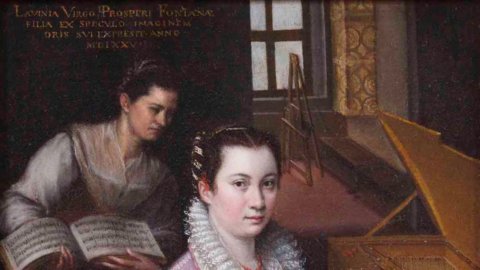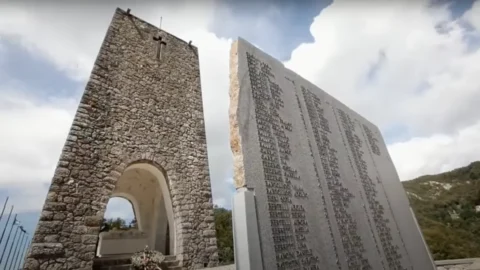One hundred magnificent works, including many absolute masterpieces, belonging to one of the oldest Italian cultural institutions, the National Academy of San Luca of Rome, come to Perugia for a wide-ranging exhibition that develops in the two prestigious locations of Palazzo Baldeschi and Palazzo Lippi Alessandri, historic buildings owned by the Cassa di Risparmio di Perugia Foundation located in the historic city center and used as museum spaces.
With Raphael, Bronzino, Pietro da Cortona, Guercino, Rubens, Wicar, Hayez, Giambologna, Canova, Valadier, Balla, there appear paintings and sculptures by other fundamental Italian and foreign artists, to document the great art between the fifteenth and the recent twentieth century.
The exhibition that will remain open until 30 September 2018, was born from the collaboration between the CariPerugia Arte Foundation and the National Academy of San Luca. It is edited by Vittorio Sgarbi and accompanied by a catalog published by Fabrizio Fabbri publisher with all the works reproduced and analyzed by scientific files edited by specialists and by a text, in addition to that of the curator, by Francesco Moschini Secretary General of the Academy, which gives you a quick history of the institution.
The exhibition project offers an immersion in the history of the Accademia Nazionale di San Luca, witnessed in the exhibition by paintings, sculptures, architectural drawings, preparatory sketches, all heritage of the Roman institution.
The comparison that the exhibition proposes with the Perugian and Umbrian artistic reality is stimulating. Some works belonging to the collection of the Roman institution, in fact, not only enter into dialogue with others from the Marabottini Collection permanently exhibited at Palazzo Baldeschi - this is the case of the artist Jean-Baptiste Wicar - but also with masterpieces of historic Perugian institutions, such as the 'Pietro Vannucci Academy of Fine Arts.
In this sort of artistic journey that leads from Rome to Perugia to develop in the heart of the city, the corpus of works of the Accademia di San Luca - set up in the two exhibition venues both located in Corso Vannucci, just a few meters away from each other other – unfolds overall in 12 rooms, following a chronological order.
The exhibited works have been the subject of a vast restoration campaign promoted and supported by the Forte di Bard Association which recently presented them at its headquarters in Valle d'Aosta. The CariPerugia Arte Foundation contributes to the safeguarding of the works themselves through support for the arrangement and restructuring of the Academy's deposits.
“After a demanding excavation, reconnaissance and study work – says Vittorio Sgarbi – we managed to obtain an excellent result. The deposits of the Academy have revealed an artistic heritage of immense value, with many works that are still unknown and waiting to be arranged in a congruous way. The exhibition in Aosta and this one in Perugia represent an antecedent to the creation of a new and structured Gallery within the Academy which allows for the valorisation of this heritage by bringing it out of storage and making it accessible to the public”.
Still for the seventeenth century - very well represented in the National Academy of San Luca - here are among others the Cavalier d'Arpino with his theatrical interpretation of the Capture of Christ, Peter Paul Rubens with the remarkable sketch The nymphs crowning the goddess of abundance, Anton Van Dyck with the Madonna and Child among musician angels accompanied by the relative drawing, Sassoferrato with the absolute expression of a timeless painting in the purest Madonna and Child and then Pier Francesco Mola, Swerts, Borgianni and many others.
The sixth room is a riot of masterpieces among which stand out the composure of Cupid and Venus by Guercino, the world of the visionary Flemish painter Jan de Momper, Pietro da Cortona, Maratti, to arrive at a strongly Europeanist eighteenth century which is characterized by the presence by masters such as Angelika Kauffmann, Jan Frans Van bloemen, the marine painter Claude Joseph Vernet and with the prestigious plaster casts of the great Danish sculptor Thorvaldsen and Antonio Canova, the idol who, honored by international courts, reinvents the funeral monument and whose a plaster of a detail of the Monument to Pope Clement XIII in St. Peter's dated 1784 is exhibited, all together with the two splendid antiquarian views by Pannini.
One of the rooms is dedicated to architectural drawings - of which the Academy's collection is very rich - among which the spectacular projects for a Royal Palace in Villa by Filippo Juvarra and the renewal of Rome in the projects of the Pantheon and of Piazza del Popolo by the architect Giuseppe Valadier.
At Palazzo Lippi Alessandri, visitors are welcomed by artists of the caliber of Francesco Hayez, a multifaceted Venetian artist and innovator who created The Kiss, a symbol of Italian Romanticism, Jean Baptiste Wicar, with his powerful Official Portrait of Giuseppe Valadier, Rinaldo Rinaldi with the beautiful marble portrait of Domenico Pellegrini, a painter loved by Canova. At the time of Scapigliatura, here are the modern works by Tranquillo Cremona, a mysterious Portrait of a Woman, and by Federico Faruffini, a shady Self-Portrait. Artistic expression of the twentieth century are the self-portrait of the Peasant by Giacomo Balla, the self-portrait of D'Annunzio's Lawrence Alma Tadema, the portrait of the sculptor Giovanni Nicolini created by Antonio Mancini. Perhaps the most poetic painting in the entire collection is the Portrait of Bianca standing as she crosses the rooms of the house, carrying a ceramic teapot: she is the young daughter of the painter Amedeo Bocchi, who died at the age of twenty-six in 1934.
And again, marbles by Antonio D'Este - portraying Antonio Canova - Francesco Nagni, Pietro Tenerani, Albino Candoni and bronzes by Nicola D'Antino, Francesco Coccia, Adolfo Apolloni, Attilio Selva, Aroldo Bellini and Alberto Viani to crown a journey that it stands out for being particularly authoritative from an authorial and iconographic point of view and equally varied as regards the techniques and artistic languages used.
Thanks to the renewed partnership with the Cariperugia Arte Foundation, Trenitalia is the Official Carrier of the exhibition. Those who choose the train to reach Perugia to visit the exhibition itinerary can benefit from privileged conditions on the entrance ticket. The discount is offered both to regional transport customers and to customers of Frecciarossa and other national trains. A similar initiative with Busitalia provides discounts for those presenting the bus ticket on display. Discounts also for parking thanks to the agreement signed with Saba-Sipa.
Image: Lavinia Fontana: Self-Portrait at the Spine with the Maid, oil on canvas, 27 x 23,8, 1577





